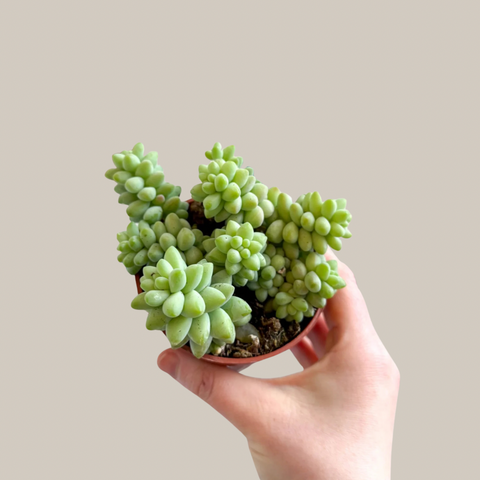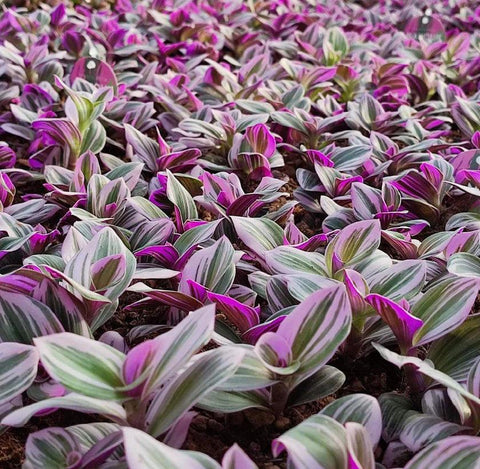Sedum burrito, also known as Burro’s Tail or Donkey’s Tail, is a show-stopping trailing succulent that's become a staple in many indoor plant collections—and for good reason! With its long, cascading stems packed with plump, blue-green leaves, it's not just adorable but also surprisingly low-maintenance if you know what it needs.
In this guide, we’ll break down everything you need to know to help your Sedum burrito thrive—from light requirements and watering tips to propagation and common problems.
🌿 Quick Overview of Sedum Burrito
- Botanical name: Sedum morganianum ‘Burrito’
- Common names: Burro’s Tail, Donkey’s Tail
- Plant type: Succulent
- Native to: Southern Mexico and Honduras
- Growth habit: Trailing, up to 3 feet long
- Toxicity: Non-toxic to pets
☀️ Light Requirements
Sedum burrito loves bright, indirect light. It thrives near a south or east-facing window, where it can soak up lots of sun without getting scorched.
Top tip: Too little light can lead to stretched-out stems and leaf drop, while too much direct sun can burn the leaves—especially if it’s been growing in low light and suddenly moved into harsh light.
💧 Watering Tips
Like most succulents, less is more when it comes to watering.
- Allow the soil to dry out completely between waterings.
- In spring and summer, water thoroughly but infrequently.
- In winter, reduce watering to once every 3–4 weeks.
Watch out for root rot! Overwatering is the number one killer of Sedum burrito. Always use the “soak and dry” method and avoid letting your plant sit in soggy soil.
🌱 Soil & Potting
Your Sedum burrito needs well-draining soil. A cactus or succulent mix is ideal, or you can make your own using:
- 2 parts potting soil
- 1 part perlite or pumice
- 1 part coarse sand
Pot choice matters, too! Always use a pot with drainage holes to help excess water escape.
🌡️ Temperature & Humidity
- Ideal temperature: 18–24°C (65–75°F)
- Minimum temperature: Keep above 10°C (50°F)
- Humidity: Low to average humidity preferred
🌱 Fertilising
Feed your Sedum burrito once a month during spring and summer with a diluted cactus or succulent fertiliser. No fertiliser is needed in autumn and winter.
✂️ Pruning & Propagation
Pruning
Pruning isn’t usually necessary unless you want to tidy up or control its length. Be gentle—the leaves are delicate and fall off easily.
Propagation
Leaf drop? Don’t panic! It’s actually a great chance to propagate.
- Let fallen leaves callous over for a day or two.
- Place on top of soil and mist occasionally.
- Wait for tiny roots and new rosettes to form!
You can also propagate from stem cuttings—just snip, let callous, and plant.
🐛 Common Problems & How to Fix Them
| Problem | Likely Cause | Solution |
|---|---|---|
| Leaves dropping easily | Normal – plant is fragile | Handle gently; avoid moving often |
| Yellowing leaves | Overwatering | Let soil dry out completely |
| Stretched stems | Not enough light | Move to brighter spot |
| Mushy stems | Root rot | Trim affected areas; repot in dry soil |
| White fuzz on leaves | Mealybugs or mildew | Wipe with alcohol or neem oil |
🐾 Is Sedum Burrito Pet Safe?
Good news! Sedum burrito is non-toxic to cats and dogs, making it a great pick for pet-friendly homes. Just be mindful that trailing stems can tempt curious paws.
❓ FAQs: Sedum Burrito Care
How often should I water my Sedum burrito?
Only when the soil is completely dry. In summer, every 2–3 weeks; in winter, much less often.
Why are the leaves falling off my Burro’s Tail?
It’s a fragile plant—leaf drop is normal if moved or touched too much.
Can Sedum burrito grow outdoors?
Yes, in warm climates (zones 9–11). In colder regions, keep it indoors during winter.
Can I hang Sedum burrito in a basket?
Absolutely! It looks stunning trailing from a hanging planter.
🌸 Final Thoughts
Sedum burrito might look delicate, but it’s a tough little succulent with a lot of charm. With the right balance of light, well-draining soil, and careful watering, this beauty will reward you with cascading greenery for years to come.



